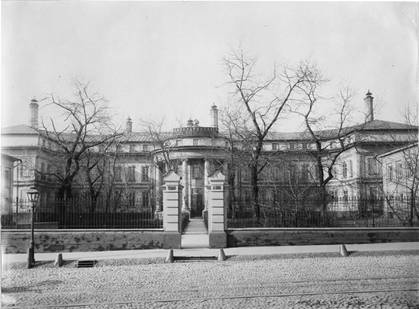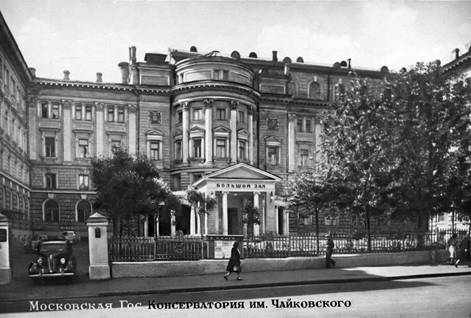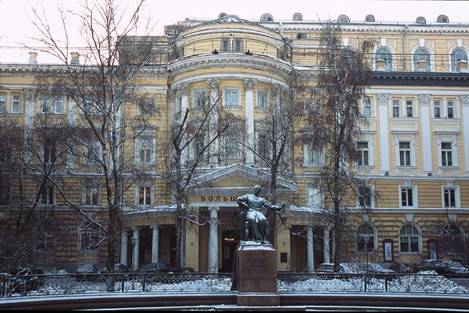

The Moscow Conservatory. 1894
The Moscow Conservatory was established in 1866 upon the initiative of the outstanding pianist, conductor and public figure Nikolay Grigor’yevich Rubinstein (1835–1881) and became famous throughout the whole world with its remarkable professors, graduates and the numerous splendid concerts taking place within its walls.
Presently it is located in a beautiful architectural ensemble joining together three tutorial buildings and five concert halls. This “musical compound” did not appear instantaneously. Its history is of particular interest. In 1766 a large bit of land situated at the address of Bolshaya Nikitskaya Street 13 passed into the possession of Princess Ekaterina Romanovna Dashkova (née Vorontsova; 1743–1810), a close friend and associate of Empress Catherine II, the director of the St. Petersburg Academy of Sciences and the president of the Imperial Russian Academy. According to her plan, a house made of stone was first built here in 1780, which later, in 1795 was rebuilt into a two-story building with a mansard storey and side wings. There is a written testimony in existence that the building was projected by the famous architect Vasily Ivanovich Bazhenov (1737–1799).
After Dashkova’s death in 1810 the building came into the possession of her nephew, Count (subsequently, His Serene Highness, Prince, General, Field Marshall) Mikhail Semyonovich Vorontsov (1782-1856), one of the heroes of the Patriotic War of 1812.
In 1871 the Russian Musical Society (RMS, with the adjective “Imperial” added in 1873, making it the IRMS) rented the building along with the area of land from Mikhail Vorontsov’s son, His Serene Highness, Prince Semyon Mikhaylovich Vorontsov (1823–1882) and in 1878 purchased it for the use of the Conservatory. However, in the course of time, this building proved to be too small for this educational institution, which was continuously expanding. For this reason in 1893 the Moscow Branch of the IRMS, not having succeeded in obtaining on a gratuitous base the area of land across from the Bolshoi Theater, was compelled to make the decision of constructing a new building for the Conservatory in place of the old one.
The task of creating this project and the leadership of its construction was entrusted to Academic of Architecture Vasily Petrovich Zagorsky (1846–1912) and to his assistant, architect Aleksandr Efremovich Nisselsohn (1856–1910), while the outward plastic decoration of the building was entrusted the well-known sculptor Aleksandr Alekseyevich Aladyin (dates of life unknown).
On June 27 1895 the ceremonial laying of the foundation stone of the new building took place. It had been constructed for eight years under the vigilant control of the director of the Conservatory himself – the famous pianist, conductor, teacher and public figure Vasily Il’ich Safonov (1852–1918).
The financial assistance for building and provision of the facilities of the Moscow Conservatory’s building was provided by members of the imperial family, merchants, industrialists and musicians. Large sum of money for this cause were granted by the State Duma and the State Treasury.
The efforts of all these people were not made in vain. In 1897 the construction of the residential building (presently the Conservatory’s Second Tutorial Building), and in 1898 the First Tutorial Building of the Conservatory and the Small Hall were completed.

The Moscow Conservatory. 1953.
In 1923 the Moscow Conservatory acquired the Third Tutorial Building and concert hall, situated at the address: Bolshaya Nikitskaya Street 11.
In 1954 the statue of the great Russian composer Pyotr Il’ich Tchaikovsky (1840–1893), whose name the Conservatory has held since 1940, was inaugurated in front of the Grand Hall of the Conservatory. The statue was designed by the famous sculptor Vera Ignatyevna Mukhina (1889–1953).

The building and Tchaikovsky statue. 1990s. Photo by V. N. Kraynov